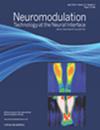A Comprehensive Review of Low-Intensity Focused Ultrasound Parameters and Applications in Neurologic and Psychiatric Disorders
IF 3.2
3区 医学
Q2 CLINICAL NEUROLOGY
引用次数: 0
Abstract
Objectives
Low-intensity focused ultrasound (LIFU) is gaining increased interest as a potential therapeutic modality for a range of neuropsychiatric diseases. Current neuromodulation modalities often require a choice between high spatial fidelity or invasiveness. LIFU is unique in this regard because it provides high spatial acuity of both superficial and deep neural structures while remaining noninvasive. This new form of noninvasive brain stimulation may provide exciting potential treatment options for a variety of neuropsychiatric disorders involving aberrant neurocircuitry within deep brain structures, including pain and substance use disorders. Furthermore, LIFU is compatible with noninvasive neuroimaging techniques, such as functional magnetic resonance imaging and electroencephalography, making it a useful tool for more precise clinical neuroscience research to further understand the central nervous system.
Materials and Methods
In this study, we provide a review of the most recent LIFU literature covering three key domains: 1) the history of focused ultrasound technology, comparing it with other forms of neuromodulation, 2) the parameters and most up-to-date proposed mechanisms of LIFU, and finally, 3) a consolidation of the current literature to date surrounding the clinical research that has used LIFU for the modification or amelioration of several neuropsychiatric conditions.
Results
The impact of LIFU including poststroke motor changes, pain, mood disorders, disorders of consciousness, dementia, and substance abuse is discussed.
Conclusions
Although still in its infancy, LIFU is a promising tool that has the potential to change the way we approach and treat neuropsychiatric disorders. In this quickly evolving field, this review serves as a snapshot of the current understanding of LIFU in neuropsychiatric research.
低强度聚焦超声参数及在神经和精神疾病中应用的全面回顾。
目的:低强度聚焦超声(LIFU)作为一系列神经精神疾病的潜在治疗方式,正受到越来越多的关注。目前的神经调控模式通常需要在高空间保真度和侵入性之间做出选择。LIFU 在这方面是独一无二的,因为它既能提供表层和深层神经结构的高空间敏锐度,又能保持无创。这种新型的无创脑刺激可能会为涉及大脑深层结构内异常神经回路的各种神经精神疾病(包括疼痛和药物使用障碍)提供令人兴奋的潜在治疗方案。此外,LIFU 与功能磁共振成像和脑电图等无创神经成像技术兼容,使其成为更精确的临床神经科学研究的有用工具,从而进一步了解中枢神经系统:在本研究中,我们对最新的 LIFU 文献进行了综述,涉及三个关键领域:1)聚焦超声技术的历史,并将其与其他形式的神经调控进行比较;2)聚焦超声的参数和最新的提议机制;最后,3)迄今为止围绕使用聚焦超声改变或改善多种神经精神疾病的临床研究的最新文献综述:结果:讨论了 "生命之光 "的影响,包括中风后的运动变化、疼痛、情绪障碍、意识障碍、痴呆和药物滥用:尽管 LIFU 仍处于起步阶段,但它是一种很有前途的工具,有可能改变我们处理和治疗神经精神疾病的方式。在这一快速发展的领域,本综述可作为神经精神疾病研究领域目前对 LIFU 理解的一个缩影。
本文章由计算机程序翻译,如有差异,请以英文原文为准。
求助全文
约1分钟内获得全文
求助全文
来源期刊

Neuromodulation
医学-临床神经学
CiteScore
6.40
自引率
3.60%
发文量
978
审稿时长
54 days
期刊介绍:
Neuromodulation: Technology at the Neural Interface is the preeminent journal in the area of neuromodulation, providing our readership with the state of the art clinical, translational, and basic science research in the field. For clinicians, engineers, scientists and members of the biotechnology industry alike, Neuromodulation provides timely and rigorously peer-reviewed articles on the technology, science, and clinical application of devices that interface with the nervous system to treat disease and improve function.
 求助内容:
求助内容: 应助结果提醒方式:
应助结果提醒方式:


